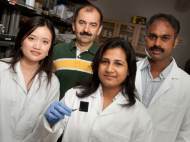Laser etched graphite oxide sheets can be used as supercapacitors
 A team of researchers from Rice University discovered they could transform a sheet of graphite oxide (GO) into a functional supercapacitor by writing patterns into it with a laser. By writing patterns of RGO into thin sheets of GO, the Rice researchers effectively turned them into free-standing supercapacitors with the ability to store and release energy over thousands of cycles.
A team of researchers from Rice University discovered they could transform a sheet of graphite oxide (GO) into a functional supercapacitor by writing patterns into it with a laser. By writing patterns of RGO into thin sheets of GO, the Rice researchers effectively turned them into free-standing supercapacitors with the ability to store and release energy over thousands of cycles.
Scientists already knew that the heat of a laser could convert GO (the oxidized form of graphite, or carbon-based pencil lead) into electrically conducting reduced graphite oxide (RGO). The surprising discovery by Rice University researchers was that hydrated GO can hold ions and serve as a solid electrolyte and an electrically insulating separator. GO soaks up water like a sponge and it can hold up to 16 percent of its weight.
“The fundamental breakthrough here is that GO, when it contains water, acts as an ionic conductor”, said Pulickel Ajayan, Rice’s Benjamin M. and Mary Greenwood Anderson Professor in Mechanical Engineering and Materials Science and of chemistry. “So we’re able to convert a sheet of GO into a supercapacitor without adding anything. All you need are a pattern and the electrodes, and you have a device. Of course the devices also perform in the presence of external electrolytes, which is even better.”
In a control experiment, vacuum was used to suck out all the water in an RGO-GO-RGO in order to eliminate its ionic conductivity. Exposing it to air for three hours completely restored its supercapacitor function. To build a fully functional supercapacitor, conducting electrode materials need to be separated by an insulator that contains the electrolyte. When laser-written patterns of conducting RGO are separated by GO, the material becomes an energy storage device. The patterns can be layered top and bottom or on the same plane.
In their experiments, heat from a laser at Rice’s Oshman Engineering Design Kitchen sucked oxygen out of the surface to create the dark, porous RGO, which provided a level of resistance and restrained the GO-contained ions until their controlled release. Patterns were written in the GO with nearly one-micron accuracy. Essentially, the devices didn’t need chemicals to exhibit good electrochemical performance.
Testing of the devices at Rice and by colleagues at the University of Delaware showed their performance compares favorably with existing thin-film micro-supercapacitors. They exhibit proton transport characteristics similar to that of Nafion, a commercial electrolyte membrane discovered in the 1960s.
Although it won’t be produced in bulk anytime soon, the newly found fundamental mechanism of graphite oxide could enable development of new devices with need of smaller power sources, use in fuel cells and lithium batteries.
For more information, you can read the article published in the online edition of Nature Nanotechnology named: “Direct laser writing of micro-supercapacitors on hydrated graphite oxide films“.









Leave your response!